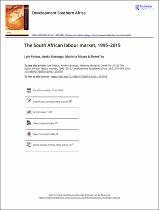| dc.contributor.author | Festus, Lyle | |
| dc.contributor.author | Kasongo, Atoko | |
| dc.contributor.author | Moses, Mariana | |
| dc.date.accessioned | 2023-03-03T10:16:36Z | |
| dc.date.available | 2023-03-03T10:16:36Z | |
| dc.date.issued | 2016 | |
| dc.identifier.citation | Festus, L. et al. (2016). The South African labour market, 1995–2015. Development Southern Africa, 33 (5) , 579-599. https://doi.org/10.1080/0376835X.2016.1203759 | en_US |
| dc.identifier.issn | 1470-3637 | |
| dc.identifier.uri | https://doi.org/10.1080/0376835X.2016.1203759 | |
| dc.identifier.uri | http://hdl.handle.net/10566/8527 | |
| dc.description.abstract | This study investigates the changes in the South African labourmarket in the post-apartheid period. While unemploymentincreased over the 1995–2015 period, employment also increased.Nonetheless, the extent of employment increase is not rapidenough to absorb all net entrants into the labour force, resultingin increasing unemployment, or an employment absorption rate of65.3%. Unemployment is concentrated in specific demographicallyand geographically defined groups, most notably Africans, thelowly educated and those aged below 30 years, residing in ruralareas in Gauteng. Finally, four worryingfindings are observed:youth jobseekers aged below 30 years struggle tofind theirfirstjob; chronic unemployment is more serious for the relatively olderjobseekers (aged 45 years or above) with past work experience;employees working for small, medium and micro enterprises stillstagnate at approximately 3.5 million; and jobseekers from theolder age cohorts are less likely to actively seek work by enquiringat workplaces and answering job advertisements. | en_US |
| dc.language.iso | en | en_US |
| dc.publisher | Taylor and Francis Group | en_US |
| dc.subject | Labour market | en_US |
| dc.subject | Labour force | en_US |
| dc.subject | Unemployment | en_US |
| dc.subject | Economic | en_US |
| dc.subject | South Africa | en_US |
| dc.title | The South African labour market, 1995–2015 | en_US |
| dc.type | Article | en_US |

